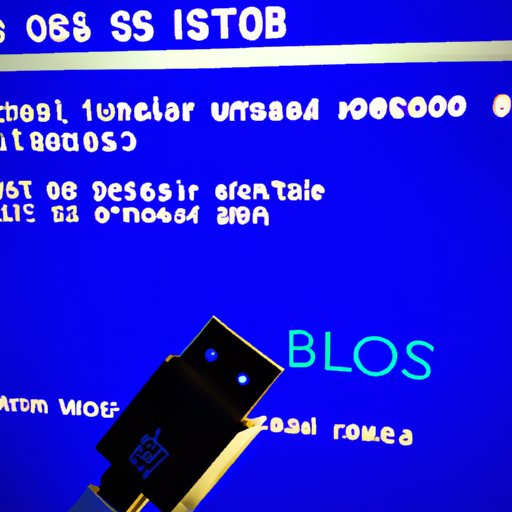Introduction
Booting from a USB is becoming increasingly popular as more systems are being built without CD or DVD drives. It’s also a great way to upgrade your computer’s operating system or install a new one. But for those who are unfamiliar with the process, booting from a USB can be confusing. This article provides a step-by-step guide on how to boot from a USB flash drive and offers helpful tips and troubleshooting advice.
Step-by-Step Guide: How to Boot from a USB
Before you begin, make sure that your computer is capable of booting from a USB. Most modern computers should be able to do this, but some older ones may not. To check if your computer is compatible, consult your computer’s manual or contact its manufacturer.
Once you’ve confirmed that your computer is capable of booting from a USB, you’ll need to prepare your USB flash drive. First, format the drive using FAT32 or NTFS file system. Then, copy the necessary files and folders onto the drive. Make sure you have all the files and folders that you need before proceeding.
Now it’s time to boot into the BIOS setup menu. This is where you’ll set your computer to boot from the USB. To access the BIOS setup menu, restart your computer and press the corresponding key when prompted (usually F1, F2, F10, Delete, or Esc). Once you’re in the BIOS setup menu, use the arrow keys to navigate to the “Boot” tab. Here, you’ll see a list of devices that your computer can boot from. Select the USB flash drive and save your changes.
Your computer will now attempt to boot from the USB flash drive. If successful, you’ll see a message prompting you to select an option. Follow the instructions on the screen to complete the boot process.

Tips for Booting from a USB Flash Drive
When booting from a USB flash drive, there are a few things you can do to ensure a successful boot. First, make sure the USB is properly formatted. If it isn’t, the computer won’t be able to read it. Second, make sure the USB is plugged in securely. If it’s loose, the computer won’t be able to detect it. Finally, try testing the USB on another computer. This will help ensure that the USB is functioning properly.

How to Make a Bootable USB and Boot from It
If you want to install an operating system or other software via USB, you’ll need to create a bootable USB first. To do this, you’ll need to download the necessary software and create the bootable USB. You can find detailed instructions for creating a bootable USB online.
Once you’ve created the bootable USB, you’ll need to set your computer to boot from it. To do this, follow the same steps outlined above. Restart your computer and press the corresponding key to enter the BIOS setup menu. Then, select the USB flash drive and save your changes. Your computer will now attempt to boot from the USB.

Troubleshooting Guide: How to Boot from USB
Sometimes, you may encounter problems while trying to boot from a USB. Common issues include the computer not recognizing the USB or the computer freezing during the boot process. If you encounter any of these issues, don’t panic. There are a few things you can do to try and fix them.
First, make sure that the USB is properly formatted and that all the necessary files and folders are present. Second, make sure the USB is plugged in securely. And finally, try testing the USB on another computer. If none of these solutions work, you may need to try a different USB or contact the manufacturer for assistance.
A Comprehensive Guide on How to Boot from a USB
Booting from a USB is a great way to upgrade or install a new operating system. The process is relatively simple, but there are a few things to keep in mind. Make sure your computer is compatible with booting from a USB, format the USB properly, and plug it in securely. Also, if you’re having trouble booting from the USB, try testing it on another computer.
If you want to install an OS from a USB, you’ll need to create a bootable USB first. To do this, you’ll need to download the necessary software and create the bootable USB. Then, follow the steps outlined above to set your computer to boot from the USB. With a bit of luck, you’ll be up and running in no time!
Conclusion
Booting from a USB is a great way to upgrade or install a new operating system. While the process may seem daunting at first, it’s actually quite simple. Just make sure your computer is compatible with booting from a USB, prepare the USB properly, and follow the steps outlined above. With a bit of luck, you’ll be up and running in no time!


